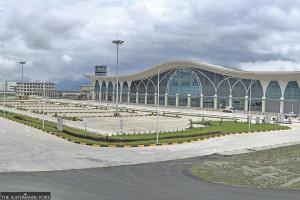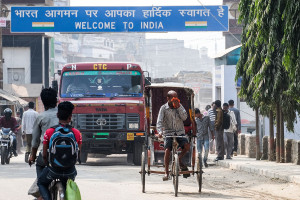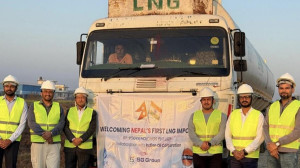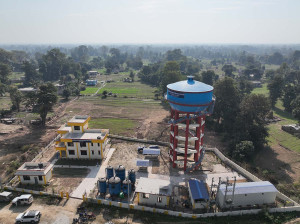Money
FDI commitment doubles, but Gen Z protest fallout could hit investor confidence
Officials warn that political uncertainty may squeeze inflows in the coming months.
Krishana Prasain
Nepal's foreign direct investment (FDI) commitments surged by 113.42 percent in the first quarter of the current fiscal year, but officials warn that the violent Gen Z protests in September could significantly dampen investor sentiment in the months ahead.
According to the Department of Industry, Nepal received FDI commitments worth Rs35.13 billion for 15,826 projects in the first three months of the current fiscal year that ended in mid-October, up from Rs16.46 billion for 7,733 projects during the same period last fiscal year.
Officials said the surge mainly came from the first two months. “The commitment in the first two months was exciting—one of the highest in many years,” said Prashant Bohara, director at the Foreign Investment and Technology Transfer Division of the Department of Industry. “However, the commitment slowed after the Gen Z protest in early September.”
They cautioned that political instability has created an uncertain environment that could discourage both foreign and domestic investors. Economists also warned that the fallout from the damage caused during the protests could be extensive if the government fails to implement credible recovery measures.
Nepal’s biggest taxpayers—including Bhat-Bhateni Supermarket, Chaudhary Group, and Ncell—suffered heavy losses during the unrest, while international hotels such as Hilton and Hyatt were also damaged. The Hotel Association Nepal estimated losses in the sector at around Rs25 billion.
Industry insiders said such incidents have not only shaken the confidence of domestic investors but also tarnished Nepal’s image as an investment destination.
“At a time when domestic investors are losing confidence and feeling insecure, I don’t see any possibility of foreign investors coming to Nepal, as the government has failed to assure safety and stability,” said Nani Raj Ghimire, executive committee member of the Federation of Nepalese Chambers of Commerce and Industry (FNCCI).
Ghimire, who also runs Shubhakamana Footwear in Sitapaila, producing the First Walk sports shoe brand, said many domestic investors are now exploring alternative destinations for business expansion.
The bulk of the FDI commitments came from large-scale industries, which attracted Rs23.14 billion for seven projects. Small-scale industries received Rs10.09 billion for 300 projects, while medium-scale industries secured Rs1.90 billion for four projects.
Sector-wise, the agro and forestry sector topped the list, drawing Rs21.63 billion for 11 projects. The tourism sector followed with Rs8.15 billion for 103 projects. The service sector received commitments worth Rs2.99 billion for 19 projects, while manufacturing attracted Rs1.45 billion for 15 projects.
The information, communication, and technology sector saw Rs716.48 million in commitments for 162 projects, and the energy sector received Rs184.25 million for one project.
Experts said the vandalism and damage to foreign-invested projects during the Gen Z protest have sent a deeply negative signal to potential investors. The government’s inability to protect private property, they added, has exposed the fragility of Nepal’s investment climate, weakened over the past decade by corruption and poor governance.
“The way investors suffered property losses signals that FDI flow will not be positive in the near future,” said Nara Bahadur Thapa, former executive director of Nepal Rastra Bank. “Amid this situation, FDI in its current state is questionable.”
He added, “Of course, there was corruption and lack of regulatory transparency, but the government also failed to send the right message and create an environment conducive to investment.”
Nepal recorded its highest-ever FDI commitments in the last fiscal year, which ended in mid-July. However, actual inflows were less than a fifth of the pledged amount, reflecting persistent challenges in converting commitments into tangible investments.
According to Nepal Rastra Bank, the country’s central bank, net FDI inflows stood at Rs12.02 billion last fiscal year, against commitments of Rs64.96 billion. While the inflow was a 41.91 percent improvement on the previous year, the gap between pledges and actual investments remains striking.
Analysts attribute this to procedural delays, outdated laws, and rampant corruption. “Foreign investors often face bureaucratic red tape and policy inconsistency in Nepal, which delays project execution and discourages reinvestment,” an economist said.
Nepal is scheduled to graduate from the category of least developed countries (LDCs) in November next year, which experts say will increase the need for foreign capital. To achieve its goal of becoming a middle-income nation by 2026, Nepal would require around $20 billion in annual FDI—an almost impossible target under the current circumstances.
Experts argue that without decisive policy reforms, improved law enforcement, and genuine efforts to ensure investor security, the country’s investment prospects will remain bleak.
“The Gen Z protests were a wake-up call,” said Thapa. “If the government fails to restore investor confidence and ensure stability, Nepal could face a prolonged investment drought.”




 8.12°C Kathmandu
8.12°C Kathmandu













